| Author |
Message |
Kirk Lee Spencer

|
 Posted: Sun 10 Jan, 2010 2:54 pm Post subject: Posted: Sun 10 Jan, 2010 2:54 pm Post subject: |
 |
|
| Sam Barris wrote: | | I always thought the sica was of Dacian origin, and related to the larger falx. I seem to remember reading something about their depictions on Trajan's columns. |
As Sam mentioned... I found this picture of a part of Trajan's column showing some Dacians each with a sica in hand. I count five.
ks
 Attachment: 130.67 KB Attachment: 130.67 KB
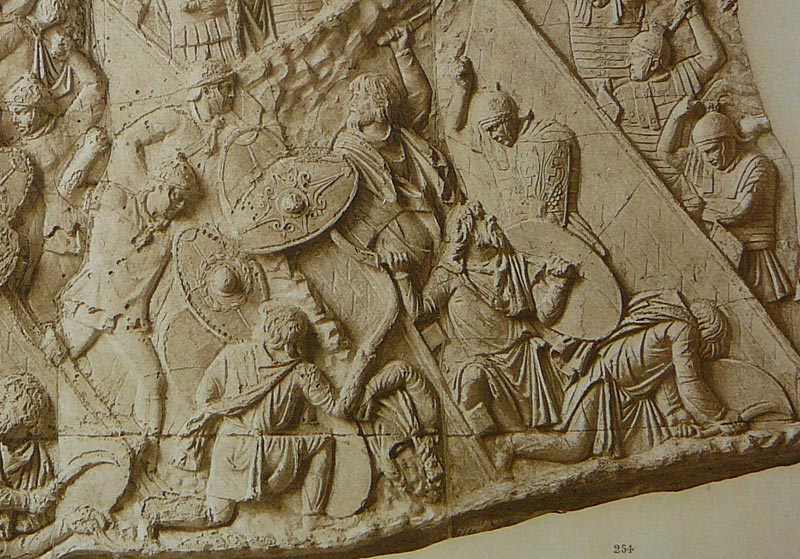
Two swords
Lit in Eden’s flame
One of iron and one of ink
To place within a bloody hand
One of God or one of man
Our souls to one of
Two eternities
|
|
  |
 |
Kirk Lee Spencer

|
 Posted: Sun 10 Jan, 2010 3:13 pm Post subject: Posted: Sun 10 Jan, 2010 3:13 pm Post subject: |
 |
|
Here is another monumental Roman carving showing a "sica-on-a-stick" (or falx)... or maybe a sica is just a single hand falx.
It appears that the legionary in the picture has his ridge helm (helmet reinforced with ridges at the top) to protect from said weapon.
The angular momentum produced by these curved blades at the end of a long handle supposedly could split helmets (and shields). Luckily a few legionaries brought their digital cameras on campaign to get this photo.  
take care
ks
 Attachment: 129.17 KB Attachment: 129.17 KB
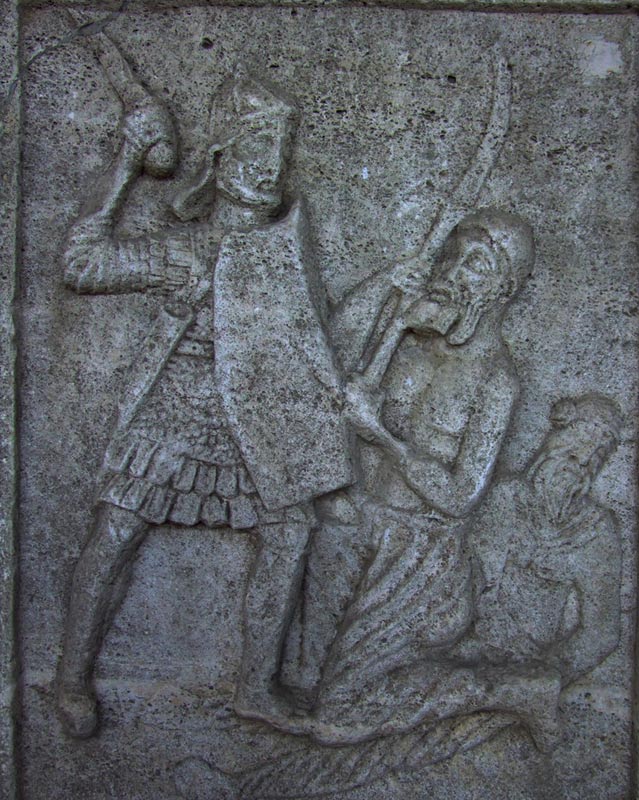
 Attachment: 141.95 KB Attachment: 141.95 KB
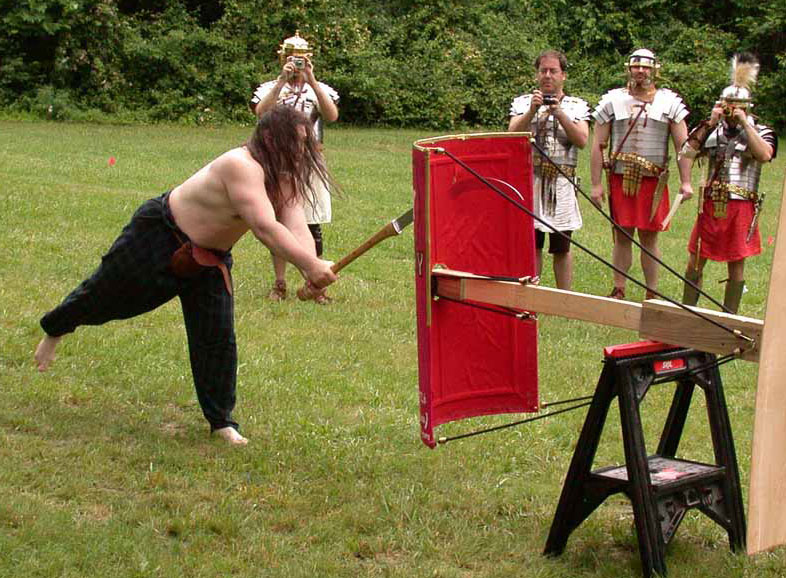
Two swords
Lit in Eden’s flame
One of iron and one of ink
To place within a bloody hand
One of God or one of man
Our souls to one of
Two eternities
|
|
  |
 |
Romulus Stoica

Location: Hunedoara, Transylvania, Romania Joined: 26 Oct 2006
Posts: 124
|
 Posted: Tue 26 Jan, 2010 11:14 pm Post subject: Posted: Tue 26 Jan, 2010 11:14 pm Post subject: |
 |
|
Here you can find the electronic version of a document describing the findings at Hunedoara, Transylvania, Romania. The document is in english and has good images and drawings of the sica daggers discovered in a dacian burial ground just near the Corvin Castle in Hunedoara. It can be downloaded here:
http://arheologie.ulbsibiu.ro/publicatii/ats/...rriors.pdf
|
|
   |
 |
|
Luke Zechman
Location: Lock Haven Pennsylvania Joined: 18 Jan 2009
Posts: 278
|
 Posted: Wed 27 Jan, 2010 6:06 am Post subject: Posted: Wed 27 Jan, 2010 6:06 am Post subject: |
 |
|
Romulus,
Thanks for posting this spectacular article. Those are some of the best looking sica remains that I have seen. This should be enough information to have a great reproduction made!! Thanks again!
|
|
  |
 |
Romulus Stoica

Location: Hunedoara, Transylvania, Romania Joined: 26 Oct 2006
Posts: 124
|
 Posted: Wed 27 Jan, 2010 6:20 am Post subject: Posted: Wed 27 Jan, 2010 6:20 am Post subject: |
 |
|
|
I also have received some last minute informations about 30 sica type daggers found in Romania, Bulgaria and former Yugoslavia. When I will clear all copyright issues I will post them also. There is an article in romanian language about them, but it contains a lot of pictures and drawings, including measurements and information about the place of discovery and the place where they can be found now (for most of them).
|
|
   |
 |
Romulus Stoica

Location: Hunedoara, Transylvania, Romania Joined: 26 Oct 2006
Posts: 124
|
 Posted: Thu 28 Jan, 2010 3:36 am Post subject: Posted: Thu 28 Jan, 2010 3:36 am Post subject: |
 |
|
I return with the other article about sica type daggers descoveries I have told about. The article is in romanian but it has a lot of pictures and you can use Google translate to get an aproximative translation. The measurements are easy to spot and translate.
There are 29 sica type daggers described there, along with a map with the places they were discovered and some related informations.
Here is the link:
http://www.enciclopedia-dacica.ro/nemvs/nemus%202009/4.pdf
|
|
   |
 |
|
Peter Johnsson
Industry Professional
|
 Posted: Thu 28 Jan, 2010 6:32 am Post subject: Posted: Thu 28 Jan, 2010 6:32 am Post subject: |
 |
|
Romulus, thank you so much for making this material available! I have been thirsting to know more about these blades for quite a while now. It is wonderful to see the different shapes and sizes.
Beautiful!
Now I am so much closer trying my hand at making one of these in my smithy!
Do you know anything about the metallurgy of these blades?
|
|
   |
 |
|
Peter Johnsson
Industry Professional
|
 Posted: Thu 28 Jan, 2010 6:36 am Post subject: Posted: Thu 28 Jan, 2010 6:36 am Post subject: |
 |
|
A related question, perhaps:
There are also these crooked swords that may be of earlier date? The shape of their blades are very similar to some type of Sica blades. I wonder to what degree they are related to each other and if they overlap in period of use?
Perhaps Romulus or someone else can tell us more about them?
 Attachment: 12.44 KB Attachment: 12.44 KB
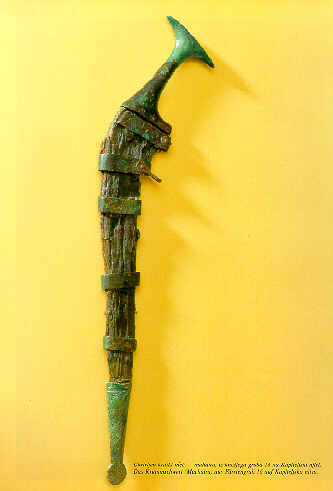
 Attachment: 30.14 KB Attachment: 30.14 KB
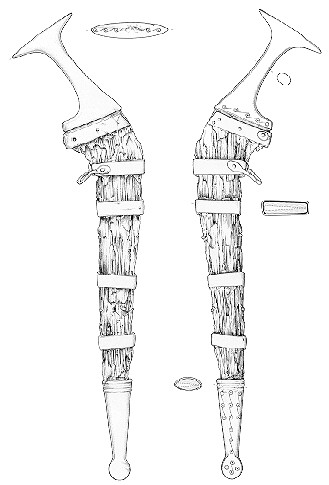
 Attachment: 20.43 KB Attachment: 20.43 KB
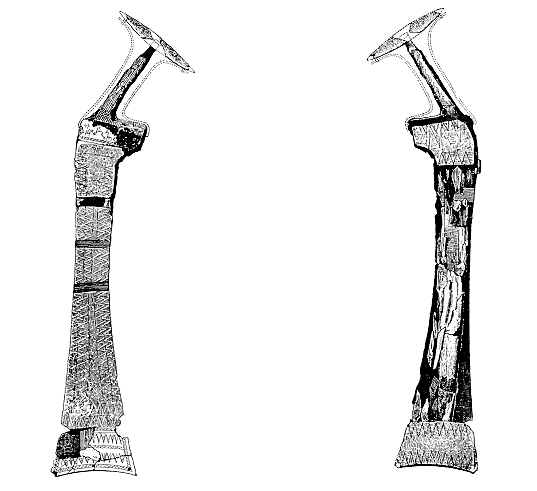
 Attachment: 9.88 KB Attachment: 9.88 KB
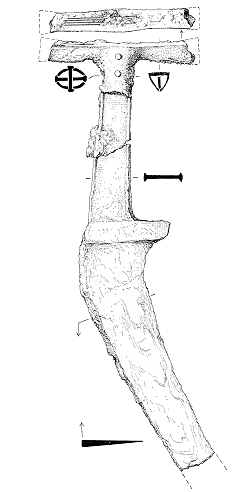
|
|
   |
 |
Romulus Stoica

Location: Hunedoara, Transylvania, Romania Joined: 26 Oct 2006
Posts: 124
|
 Posted: Thu 28 Jan, 2010 7:14 am Post subject: Posted: Thu 28 Jan, 2010 7:14 am Post subject: |
 |
|
As far as I know, those blades are thracian or illyrian and predates the sica type daggers. It is possible that they are among the ancestors of the sica. I remember seeing a similar blade (fragmented) discovered in Romania but from an earlyer period, maybe V or IV century BC, I can't remember correctly.
Also I think there is something similar in the "Thracians" Osprey book.
About the metallurgy of the sica, there are little research. I haven't any serious informations about this subject.. yet ... I have to "dig" more  ... ...
|
|
   |
 |
|
Luke Zechman
Location: Lock Haven Pennsylvania Joined: 18 Jan 2009
Posts: 278
|
 Posted: Thu 28 Jan, 2010 11:21 am Post subject: Posted: Thu 28 Jan, 2010 11:21 am Post subject: |
 |
|
I would like to echo what Peter has mentioned above. I have searched high and low on the internet for anything involving these blade, and these two links are leaps and bounds more then everything I had previously gleaned from the internet. Thanks again!! Now I just need to learn to speak Romanian 
|
|
  |
 |
Romulus Stoica

Location: Hunedoara, Transylvania, Romania Joined: 26 Oct 2006
Posts: 124
|
 Posted: Thu 11 Feb, 2010 10:34 pm Post subject: Posted: Thu 11 Feb, 2010 10:34 pm Post subject: |
 |
|
I have found some informations about the metalurgy of the dacians with some research done by Ing. Dr. Romulus Vasile Ioan (he was a university professor and manager of the Hunedoara steel works and he is General Manager of the Resita steel works now ) together with Prof. Sirbu. He has done some metaographic study of some dacian tools at Hunedoara and also about a dacian furnace.
He has a blog where he has posted some of his work, published also in a book I believe. The blog is in romanian so it would be quite hard to read for someone that doesnt speak our language.
As a brief sumary, he writted there that one of the "secrets" of the dacian blades was the high content of manganese of the dacian ore and also that the dacians used some sort of thermal treatment of enriching the superficial carbon content similar with the celtic, and roman technology.
Here is the link to his blog:
http://romulusioan.blogspot.com/
|
|
   |
 |
|
Peter Johnsson
Industry Professional
|
 Posted: Fri 12 Feb, 2010 2:01 am Post subject: Posted: Fri 12 Feb, 2010 2:01 am Post subject: |
 |
|
Romulus,
Thank you for your efforts!
It is much appreciated.
|
|
   |
 |
|
Dada Mamusa
|
|
  |
 |
|
Danny Grigg
|
|
  |
 |
|
Tomas Mihalyi
Location: Slovakia Joined: 14 Sep 2009
Posts: 21
|
 Posted: Fri 21 May, 2010 11:51 pm Post subject: Posted: Fri 21 May, 2010 11:51 pm Post subject: |
 |
|
I was wondering if anybody has an actual sica find foto because the opinions an it blade differ a lot....sica on these pictures is curved negativly and it single edged but sicas on roman monuments show sica as a double edged dagger curved positivly so it is pointing upwards....
this is quite strange cause most of the swords or daggers of thracian or Ilyrian origin are curved negativly so downwards such as machaira/kopis, Donja Dolina type swords or also Šmihel type swords...the line of evolution begins somewhere in central Europe in Halstatt B I suppose .... because of this sicas blade top should be pointing down but the monuments are quite confusing....so does anyone had any experience with this?
 Attachment: 29.02 KB Attachment: 29.02 KB
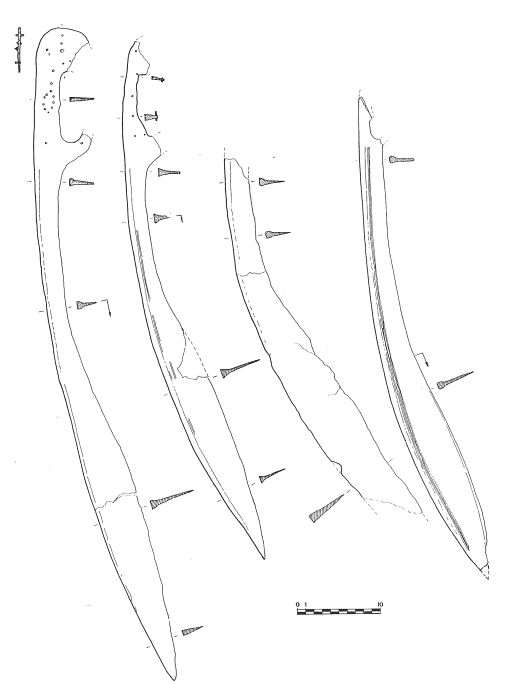
machaira/kopis
 Attachment: 6.89 KB Attachment: 6.89 KB
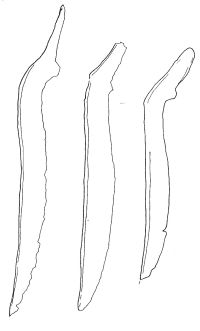
Donja Dolina swords
 Attachment: 2.72 KB Attachment: 2.72 KB
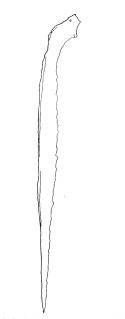
Šmihel sword
 Attachment: 43.59 KB Attachment: 43.59 KB
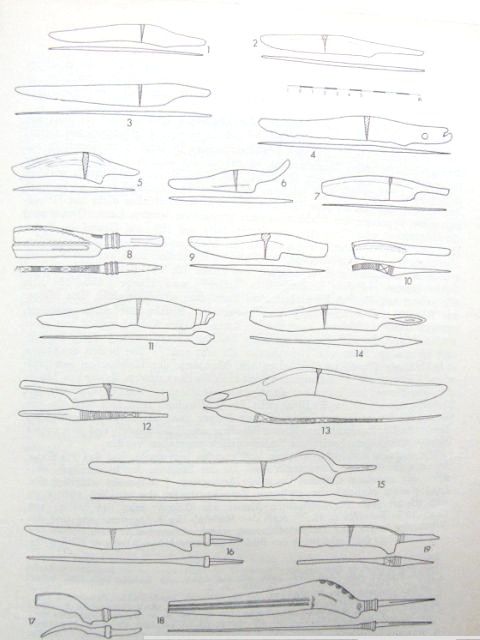
find from Morava, Chech Republic, Halstatt B1
|
|
   |
 |
Kirk Lee Spencer

|
 Posted: Wed 26 May, 2010 9:47 pm Post subject: Posted: Wed 26 May, 2010 9:47 pm Post subject: |
 |
|
| Danny Grigg wrote: |
...Kirk did you ever get around to replicating a Sica yourself?
Thanks
Danny |
Hi Danny...
I got around to thinking about replicating a Sica... several times 
But alas, I've not finished the project.   
I did finally decide on the outline of the blade and tang. I even broke out my dremel cut-off wheels and began cutting it out of the cable damascus discard Geno gave me from his Center Cross Forge.
http://www.centercross.com/Current/forged.htm
In all my thinking about the project, I gave up on the Olive Wood idea and have now settled (for the moment) on a hilt of Wenge with the grip out of a nice piece of Lignum Vitae I found at my nearby Rockler Store. It is exactly four inches long and has center wood down the middle with no checks... perfect for a grip. I really like the grain texture of Lignum Vitae. And it is a caramel brown color rather than the usual green (thus the name).
Even more I have made a few photoshop pastiches to try and get an Idea of the overall design. Anyway...
Thanks for the interest Danny...
take care
ks
 Attachment: 128.5 KB Attachment: 128.5 KB
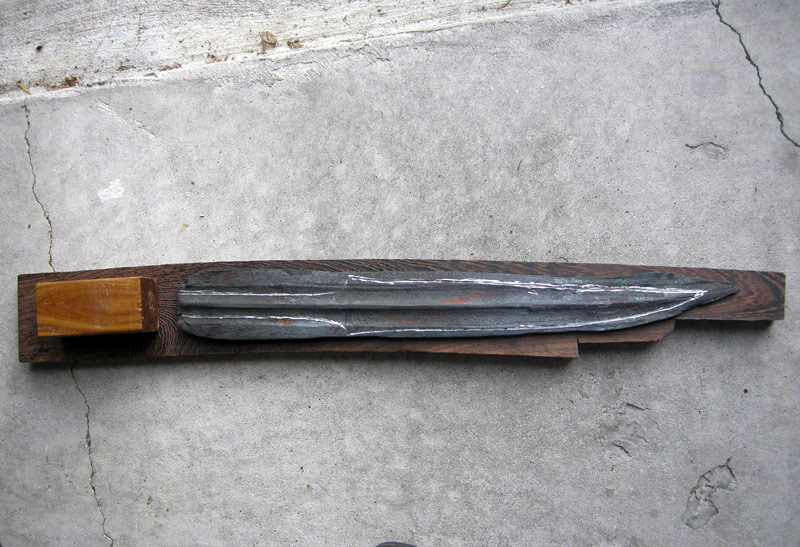
 Attachment: 18.35 KB Attachment: 18.35 KB

Two swords
Lit in Eden’s flame
One of iron and one of ink
To place within a bloody hand
One of God or one of man
Our souls to one of
Two eternities
|
|
  |
 |
|
Dada Mamusa
|
 Posted: Mon 14 Jun, 2010 12:10 pm Post subject: Posted: Mon 14 Jun, 2010 12:10 pm Post subject: |
 |
|
Feared sign of prestige, with a special spiritual load, the sica dagger is a reference point in the attempt to establish the proportions of the Thracian military phenomena on the whole, but especially the role in society of the military elite. Our approach tries to bring into discussion a typological repertory, with the artistic and spiritual implications that can be built around this weapon, with the necessary prudence, starting with the iconographical, archaeological, historiography sources, the symbolist interpretation and experimental archaeology.
One of the most characteristic curved weapons that can be found in the panoply of the Thracians is a sharp dagger, with a curved blade and a triangular section, with a “blood channel” along the blade and zoomorphic or geometrical motifs incised into it. The size of this dagger, generically called sica, varies between 25 and 35 cm length. The rashness, with which various curved weapons of medium size, dispersed in the Thracian world, of machaira or falx type, are considered to be daggers, has made it extremely hard to catalogue and to study the real daggers, despite de fact that the lasts are present, in a relatively big number, in archaeological contexts and also in representational art. The large number of pieces discovered, with various characteristics, but all specific for daggers, along with the ambiguity of the antic sources, obliges us to make a difference between daggers and small swords (machaira), which is possible only by taking into account the functional and physical characteristics of the weapons in discussion.
From a morphological point of view, starting with simple shapes, through successive transformations, at the end of the third century B.C. and the beginning of the next century, a final shape is reached, functionally and aesthetically elaborated, proper for a mixed warrior elite, whose arsenal contains also a Thracian component. The area covered by these warriors is the North – Western Bulgaria, Western Muntenia, a good part of Oltenia, with a consistent expansion in South – Eastern Transylvania, simply said: the archaeological and cultural grounds called Padea-Panagjurski Kolonii, where the inventory also contains curved daggers of the sica type.
From a typological point of view, though there is a strong tendency towards standardization, the sica daggers can be organised in three main types that differ only by morphological aspects, not functional.
The first type is characterised by its solidity, sometimes with a broken figure immediately after the blade’s middle part, with a short and sharp point, with a slight curvature, a short handle cane, usually of a triangular shape, that has a hole for the fixing rivet, close to the blade. The blade has incised ornaments and a "blood channel" deeply carved into it. These characteristics are not general, the only standing arguments for this type being the size and the shape approximately similar.
The second type, not very different morphologically speaking, doesn’t have the solid shape of the first type, but a longer blade, with a "blood channel", and keeps, most often, the haft’s tongue short and of a triangular shape.
The third type, more numerous, gathers a series of daggers characterized by a long blade, elegantly manufactured in most cases, by the ornamentation with incised circles or/and lines along the blade, the presence of the "blood channel", the haft’s tongue as long as the haft and a guard muff. These distinctive elements are found either all together, or some of the pieces present one or more of these cha-racteristic features. The sizes show a relative standardization, some-where around 30-40 cm length and approximately 3 cm width. From a chronological point of view, this type of dagger is dated mostly in the second and first centuries B. C.
The most frequent associations of weapons in the graves from the Padea-Panagjurski Kolonii group are spear tips, the helmet, the straight sword, shield bosses and the curved dagger, sometimes a coat of mail and chariots, and adding different pieces of harness: pasterns, bits, buckles. This type of funeral inventory, almost the same in the graves from where the daggers come, allows today the identification and reconstruction of some specific inventories, scattered along the time because of different reasons.
The daggers’ decoration, remarkably complex, offers them a sum of spiritual, artistically and symbolical valences. On the blade geo-metrical shapes were incised, but also eagles and snakes, in which case their schematization requires the existence of a certain “code”, or they were an emblem that underlined the membership of a certain brotherhood at arms or a certain social status.
From the facts presented above, it can be stated that the sica dagger represents an important historical artefact which, due to it’s importance and the role it played in the Thracian world, contributes to the understanding of the social and military mechanisms of this society and, through the special spiritual dimension, to the reception of a new side from the religious mosaic of this people. From all the curved weapons used in the Thracian area, the sica daggers are the only ones that make the connection between the Southern Thracians and the Thracians North to the Danube, being spread the same on both sides of the river.
Dada
http://www.enciclopedia-dacica.ro/nemvs/nemus%202009/4.pdf
|
|
  |
 |
|
Tom Emerson
Location: Amherst MA Joined: 09 Sep 2010
Posts: 1
|
 Posted: Thu 03 Mar, 2011 2:16 pm Post subject: Historical image of the Sica Posted: Thu 03 Mar, 2011 2:16 pm Post subject: Historical image of the Sica |
 |
|
| Kirk Lee Spencer wrote: | | The largest sica I can find associated with gladiators in period images is this stone carving. |
This is not actually a Sica, because the gladiator carrying it is a Secutor, not a Thracian, the Thracian being the only known Gladiator who carried the Sica. The Secutor carried a simple Gladius, which is depicted in the image. The sword is merely bend slightly due to the perspective and the way it was carved.
The Secutor is characterized by the helm ,which had no crest, and had only two small sights. The Thracian had a helm with a wide brim, and a crest curved forward with a gryphon head mounted on the front. The Thracian also wore two tall greaves, which this figure does not.
Here is an image from a mosaic. The Gladiator kneeling to the far left is a Thracian, and you can clearly see his Sica.
http://www.google.com/imgres?imgurl=http://ww...29,r:2,s:0
If the man is down, take him then or he will surely rise to take you.
|
|
   |
 |
|
Vald Bard
Location: Arbe Joined: 26 Jul 2011
Posts: 1
|
 Posted: Tue 26 Jul, 2011 1:30 pm Post subject: Posted: Tue 26 Jul, 2011 1:30 pm Post subject: |
 |
|

SICA (Thika) means Knife in Illyrian. I guess it was considered as such.
|
|
  |
 |
Tom Carr

|
|
   |
 |
|
|
You cannot post new topics in this forum
You cannot reply to topics in this forum
You cannot edit your posts in this forum
You cannot delete your posts in this forum
You cannot vote in polls in this forum
You cannot attach files in this forum
You can download files in this forum
|
All contents © Copyright 2003-2024 myArmoury.com — All rights reserved
Discussion forums powered by phpBB © The phpBB Group
Switch to the Basic Low-bandwidth Version of the forum
|

